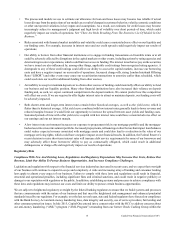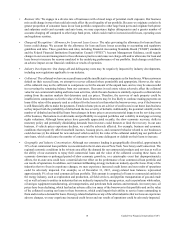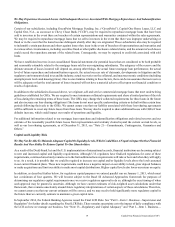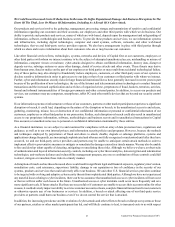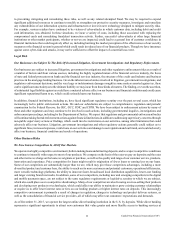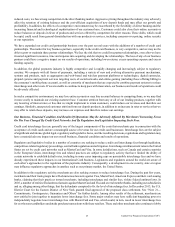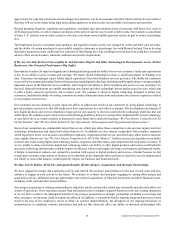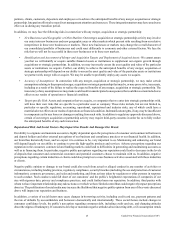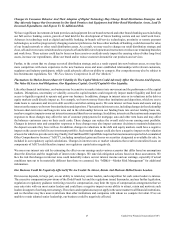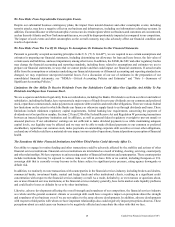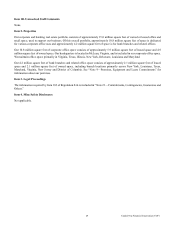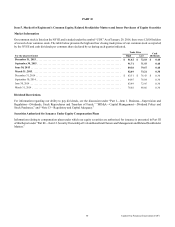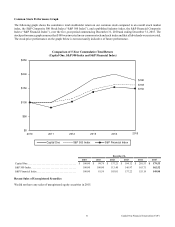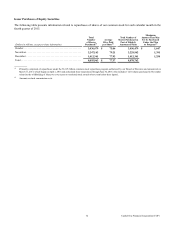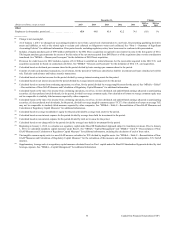Capital One 2015 Annual Report Download - page 45
Download and view the complete annual report
Please find page 45 of the 2015 Capital One annual report below. You can navigate through the pages in the report by either clicking on the pages listed below, or by using the keyword search tool below to find specific information within the annual report.26 Capital One Financial Corporation (COF)
decline or if we fail to maintain and enhance our brand, or we incur significant expenses in this effort, our business and financial
results could be materially and negatively affected.
If We Are Not Able To Protect Our Intellectual Property, Our Revenue And Profitability Could Be Negatively Affected.
We rely on a variety of measures to protect and enhance our intellectual property, including copyrights, trademarks, trade secrets,
patents and certain restrictions on disclosure, solicitation and competition. We also undertake other measures to control access to
and distribution of our other proprietary information. These measures may not prevent misappropriation of our proprietary
information or infringement of our intellectual property rights and a resulting loss of competitive advantage. In addition, our
competitors or other third parties may file patent applications for innovations that are used in our industry or allege that our systems,
processes or technologies infringe on their intellectual property rights. If our competitors or other third parties are successful in
obtaining such patents or prevail in intellectual property-related litigation against us, we could lose significant revenues, incur
significant license, royalty or technology development expenses, or pay significant damages.
There Are Risks Resulting From The Extensive Use Of Models In Our Business.
We rely on quantitative models to aggregate and assess our various risk exposures and to estimate certain financial values. Models
may be used in such processes as determining the pricing of various products, grading loans and extending credit, measuring
interest rate and other market risks, predicting losses, assessing capital adequacy, and calculating economic and regulatory capital
levels, as well as to estimate the value of financial instruments and balance sheet items. Poorly designed or implemented models
present the risk that our business decisions based on information incorporating models will be adversely affected due to the
inadequacy of that information. Also, information we provide to the public or to our regulators based on poorly designed or
implemented models could be inaccurate or misleading. Some of the decisions that our regulators make, including those related
to capital distribution to our shareholders, could be affected adversely due to the perception that the quality of the models used to
generate the relevant information is insufficient. Any issues with the quality or effectiveness of our data aggregation and validation
procedures, as well as the quality and integrity of data inputs, could result in ineffective risk management practices or inaccurate
risk reporting. If our risk management framework proves ineffective, we could suffer unexpected losses which could materially
adversely affect our results of operation or financial condition.
Our Risk Management Strategies May Not Be Fully Effective In Mitigating Our Risk Exposures In All Market Environments
Or Against All Types Of Risk.
Management of risk, including market, credit, liquidity, compliance and strategic risks, requires, among other things, policies and
procedures to record properly and verify a large number of transactions and events. See “MD&A—Risk Management” for further
details. We have devoted significant resources to developing our risk management policies and procedures and expect to continue
to do so in the future. Nonetheless, our risk management strategies may not be fully effective in identifying and mitigating our
risk exposure in all market environments or against all types of risk, including risks that are unidentified or unanticipated, even if
our models for assessing risk are properly designed and implemented.
Some of our methods of managing risk are based upon our use of observed historical market behavior and management’s judgment.
These methods may not accurately predict future exposures, which could be significantly greater than the historical measures
indicate. For example, market conditions during the financial crisis involved unprecedented dislocations and highlight the
limitations inherent in using historical information to manage risk. In addition, credit risk is inherent in the financial services
business and results from, among other things, extending credit to customers. Our ability to assess the creditworthiness of our
customers may be impaired if the models and approaches we use to select, manage and underwrite our consumer and commercial
customers become less predictive of future charge-offs (due, for example, to rapid changes in the economy, including the
unemployment rate).
While we employ a broad and diversified set of risk monitoring and risk mitigation techniques, those techniques and the judgments
that accompany their application cannot anticipate every economic and financial outcome or the timing of such outcomes. For
example, our ability to implement our risk management strategies may be hindered by adverse changes in the volatility or liquidity
conditions in certain markets and as a result, may limit our ability to distribute such risks (for instance, when we seek to syndicate
exposure in bridge financing transactions we have underwritten). We may, therefore, incur losses in the course of our risk
management or investing activities.


